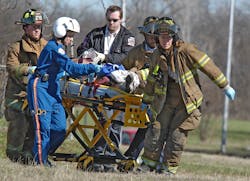EMS Training? Not Again!
There has been a definite shift toward first responder or medical calls in most areas. No longer can you be a firefighter alone; many departments require you to be a minimum of EMT or have first responder training. Other departments are handling so many medial calls that they staff engines or other apparatus at the advanced life support level with paramedics. While there are still departments that are fire response only they are becoming fewer and fewer, and even those agencies find themselves assisting EMS crews on a regular basis.
Why did I spend time stating the obvious about the fire service? Why spend time talking about a subject that inflames many when they will tell you “EMS and medical is not what I signed up for!”? The answer to both questions is very simple. First, it is important that we understand that medical calls are here to stay in the fire service. Second, while medical calls are not something you want to do, it is still a valuable life saving service provided to the community.
Let’s concentrate on the fact that running medical calls is not what many firefighters want to do. Human nature causes us to shy away from what we do not like. If you do not like a certain food, you don’t eat it. If you don’t like a particular television show, you change the channel to what you do like. This same human nature is evident at the firehouse. It is seen during training and in discussions among staff. Many times you hear I hate to run medical calls, or oh no, it’s time for medical training. Fact is we will avoid what we do not like when we train.
Companies will spend half a day honing their skills on establishing a water supply, repacking hose and doing it over and over. They will even use a stop watch to see who can do it fastest and to make everyone decrease the time it takes. Dragging and deploying hoselines up steps over and over or practicing Mayday drills. All these are done in training with such a repetition that at a fire things go smoothly and rarely are mistakes made in the area of basic skills. What if we had the same positive attitude and repetition towards EMS training?
Recently while completing an on-line training course I was reminded that, in the setting of cardiac arrest, the fire department is the initial access to CPR for a large percent of the time. It was also pointed out that studies show that, while firefighters should perform some of the best CPR around, we do not. People look at the fire department as saviors a lot of times and this comes with a certain pride that we have to live up to. I know EMS training can get boring and redundant; I train folks all over my area and hear “we just did that last year.” Well guess what, we have the responsibility to our community to do it over and over just like our water supply and Mayday drills.
Set up training days where CPR is the focus, review the proper way to perform CPR on age-specific patients. Use repetition to make it better and more effective. Concentrate on problems that crew members are having, such as hand placement, rate and depth of compression, and proper ventilation. Practice it in a one- and two-person situations over and over until it is right. Once you have it down, do it again except this time make a game of it. Have a competition to see which crew does the most effective CPR. Trust me, these are firefighters; give them the opportunity to compete against one another and it’s on. You will see some of the best CPR you have ever seen, and don’t look now but your people are having fun while learning or practicing. Do not forget to integrate the use of the automated external defibrillator (AED) into your training. It's a goof reminder that the early defibrillation is key in successful resuscitation from cardiac arrest.
The key to EMS training is to make it as interesting and active as fire training. Get it out of the classroom and into the hands-on setting as soon as possible. Create a fun environment for practice and integrate fire and rescue into the training often for example use of ropes to move the patient or airbags to gain access. No where does it say you can’t train on more than one thing at a time. As far as fun goes, when the crew and the individual is happy with how well they fully package a patient for transport, or immobilized a fracture put them in the dark. Yes put them in a dark room. Can they still do it as well? While performing EMS skills in pitch black conditions is not realistic it makes you think about each thing you are doing, and it’s fun to see if you can do it.
I know training on the same thing over and over gets old. But remember a lot of it is about attitude; try to keep the perspective of how important EMS calls are to the community. As busy as our ambulances are today you are often going to be first at medical calls.
My dad said it best, “son anything you do in life is like digging a ditch. You may not like it, but you may as well do it right.” Spend some time with EMS training make it repetitive but make it fun.
